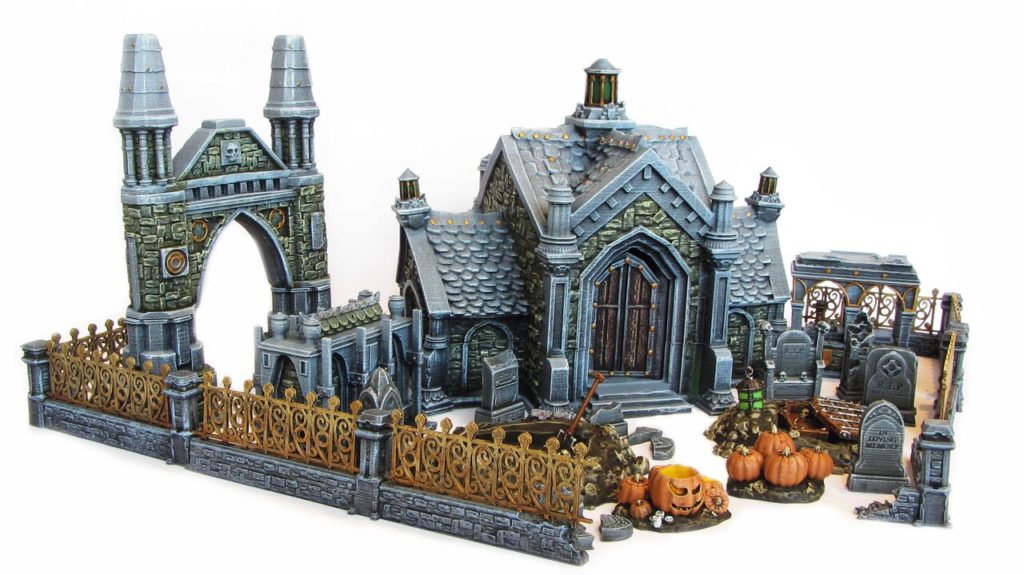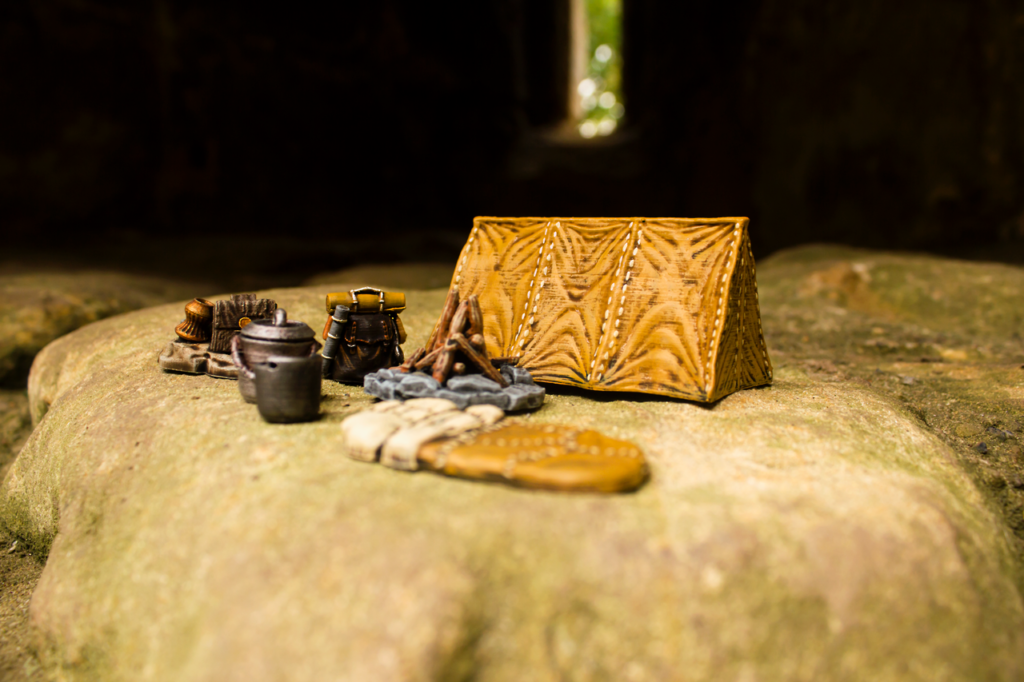Since Dungeons & Dragons made its debut in 1974, tabletop role playing games (RPGs) have been steadily gaining in popularity. These kinds of games rely upon established sets of rules, game arbitrators, and strategic imagination, and the experience of playing is often enhanced by the use of miniatures and props. In fact, an entire culture of crafting has developed side-by-side within the gaming community. From character figures to dioramas, the physical paraphernalia has become as much a part of the culture of RPG as the games themselves.
 The RPG community is steeped in open source ideology. This, combined with an admiration for the ability to create beautiful objects with minimal funds, has led some to easily embrace the potential offered through 3D printing. This has not been without internal debate, however. While it is easy to appreciate the talents of someone who handcrafts an object, especially if that person has an ability that the viewer lacks, the conversation about 3D printing’s democratization of creation has also somewhat undermined its credibility as an artistic tool.
The RPG community is steeped in open source ideology. This, combined with an admiration for the ability to create beautiful objects with minimal funds, has led some to easily embrace the potential offered through 3D printing. This has not been without internal debate, however. While it is easy to appreciate the talents of someone who handcrafts an object, especially if that person has an ability that the viewer lacks, the conversation about 3D printing’s democratization of creation has also somewhat undermined its credibility as an artistic tool.
People are most impressed by art that they themselves could not create, and as we are all constantly told that 3D printing lets anybody make anything, some find themselves questioning the value of 3D printed objects. This divide over the acceptibility of 3D printing as a method for making for RPG runs along some of the same fault lines as those which divide gamers who earn their way forward and those who buy their way up the chain. But this dismissal of 3D printed objects comes from a fundamental misunderstanding of the notion “anyone can print.” Yes, it is true that more people can create in this way than ever before, but in order to do so, they must still have something to print and that is where the artistry of 3D modeling divides the hobgoblins from the bugbears, so to speak.
The artistic talent behind the tabletop creations offered by Hobgoblin 3D is clear in the details. Founders Jordan Knights, Kevin Miree, and Lawrence Williams have used their design and technological wizardry to create a whole slew of miniatures and props for tabletop games, and created a business model in which they offer the STL files for sale to be 3D printed by the individual who buys them. Their current prop offerings include dozens of objects from architecture to furniture to atmospheric open grave sites, all ready for download and printing by the purchaser. Even if you don’t have a 3D printer, there are a number of print on demand services, and more cropping up all the time, that will let you inexpensively print your purchase.
 The files are inexpensive, in keeping with the desire for low cost and accessibility, ranging from $1.50 for smaller items to $15 for the Mayan Temple, with bundles of related items ranging from $15 to $45. Once purchased, you receive the STL file for 3D printing on your own, so what you are paying for here is the aesthetic of the team at Hobgoblin and their 3D modeling expertise. This has always been a harder sell in areas in which technology is used as a mechanism for creation; think, for example, of everyone who fancies themselves a photographer now that we don’t have to use darkrooms to develop film anymore. As Miree explained in an interview with 3DPrint.com earlier this year:
The files are inexpensive, in keeping with the desire for low cost and accessibility, ranging from $1.50 for smaller items to $15 for the Mayan Temple, with bundles of related items ranging from $15 to $45. Once purchased, you receive the STL file for 3D printing on your own, so what you are paying for here is the aesthetic of the team at Hobgoblin and their 3D modeling expertise. This has always been a harder sell in areas in which technology is used as a mechanism for creation; think, for example, of everyone who fancies themselves a photographer now that we don’t have to use darkrooms to develop film anymore. As Miree explained in an interview with 3DPrint.com earlier this year:
“There’s an expectancy by many that digital art should come cheap, that you should just work for exposure, or that because a computer was involved, it somehow does all the work, the mythical ‘make art button’ as it were, but this isn’t the case. Ask any digital sculptor, or 3D artist, what it takes to create an item and they’ll tell you it’s a laborious, and technical process.”
The key with Hobgoblin’s creations though is that they are really very good. The copper vessels have the hammered texture, the filagree on the Gothic furniture is on point, and the heightened atmosphere surrounding Mayan temples is present in their creations. The countless hours of design, or the time spent being chained to their desks and poked at with sharp sticks, before the modeling can even begin are clear in each of their pieces. And despite the fact that their design team claims to be “fed on a nutritious diet of chicken bones and pizza crust”, they have turned to Kickstarter to get an infusion of funds that would allow them the time to expand their sculpted universe AND put food on the table.
At the end of this month, they will launch their fundraising campaign, which will feature a number of new pieces for the village of Raghaven. I’ve had a chance to take a sneak peek behind the curtain as they develop their Kickstarter page and, while I can’t reveal any of the details, the rewards for donating are cooler than Christmas. The fantasy hamlet they have created began as a single tavern, The Wobbly Goblin, an ideal location from which to embark upon adventure. The tavern is also chock full of tiny treasures, each of which is enjoyable in its own right.
The campaign promises to be a long one, extending beyond the holiday season, a clever way to give people a place to send their extra cash or to save up after the holiday expenses in order to add a bit of spark to a cold, dark winter. There’s a wide variety of levels and some pretty cool extensions to entice hardcore fans and newcomers alike.
Miree tells 3DPrint.com more about the campaign’s offerings:
“We’ll be staying close to our core strengths on this project; plenty of filler items, scatter terrain, bricks and mortar, all with that distinctive goblin flare. The project is intended to be the start of our Tavern-Born series, the core of the Kickstarter will be the Wobbly Goblin Tavern and the wider stretch goals will unlock various parts of the surrounding hamlet which we’re calling Raghaven. From the cottages to the Blacksmiths, market stalls to poop houses, we’ll be pulling out all the stops! The funding won’t just help the project, it will help us lead in to some wider goals down the line, advanced features on the website, the development of a full game world, possibly even a game system, but like all good adventures, it starts with a tavern…because let’s face it: no good story ever started with “I had salad…”
Keep an eye on the Hobgoblin 3D website for weekly and monthly sales, in the meantime. Stay tuned for the November 30th Kickstarter launch date (you can sign up to be notified upon launch and receive a free STL file here) and save up to get in on the ground floor while supporting the creation of some pretty awesome stuff.
What do you think of this news? Let us know your thoughts; join the discussion of this and other 3D printing topics at 3DPrintBoard.com or share your thoughts below.
Subscribe to Our Email Newsletter
Stay up-to-date on all the latest news from the 3D printing industry and receive information and offers from third party vendors.
You May Also Like
IperionX Inks 10-Year Deal with Wisconsin Manufacturer for 80 Metric Tons of Titanium Per Year
IperionX, the Charlotte-based supplier of sustainable titanium powders used for additive manufacturing (AM) and metal injection molding (MIM), has signed a ten-year deal with United Stars, a group of industrial...
Gastronology Launches Industrial Production of 3D Printed Food for Dysphagia Patients
Food 3D printing has, in many ways, been an additive manufacturing (AM) segment looking for the right business case. While some applications are beautiful and others may or may not...
Lockheed Martin Leads $3M Investment in Q5D’s Electronics 3D Printing System
Q5D, an original equipment manufacturer (OEM) of robotic arm, hybrid additive manufacturing (AM) systems used for wire harness production, has closed a $3 million investment round. The investment arm of...
3D Printing News Briefs, April 6, 2024: Depowdering, Cybertruck Door Handles, & More
In today’s 3D Printing News Briefs, ioTech’s digital manufacturing CLAD technology is opening up opportunities for microelectronics and additive manufacturing. Hexagon and Raytheon Technologies commercially released the Simufact Additive Process...

































